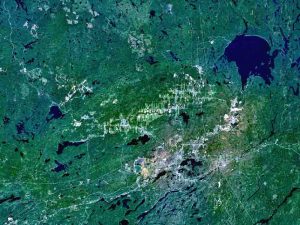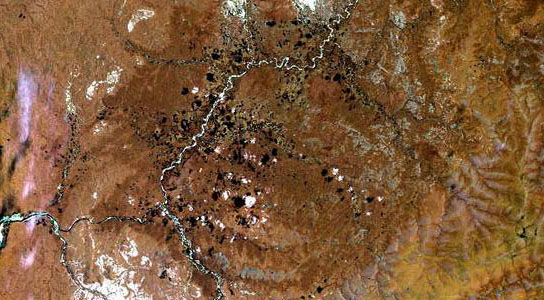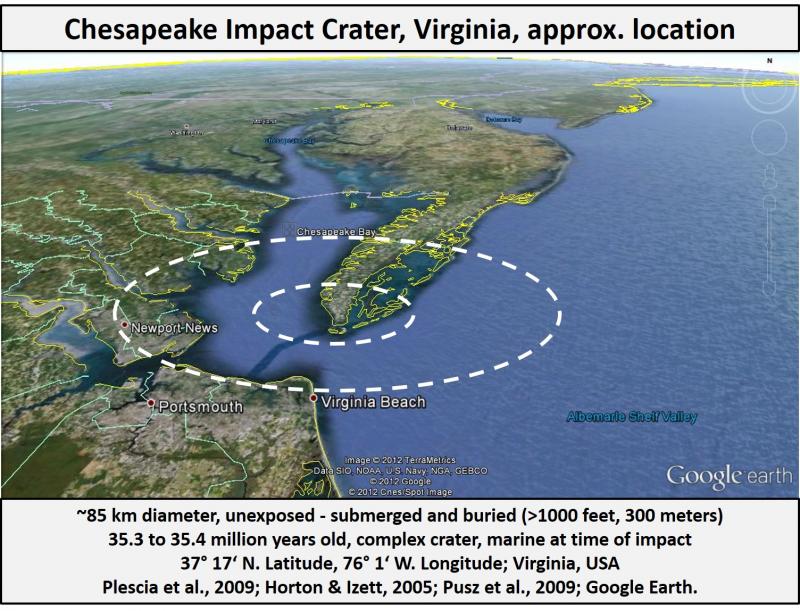Whether they’re the size of a molehill or a mountain, meteorite impacts are one of the most destructive forces in the solar system. Here on Earth, flying space debris triggered mass extinctions, but the same deadly asteroids might also have delivered the seeds of life soon after Earth was born. The effects of asteroid impacts linger for billions of years. Here are the 10 biggest impact craters known, from largest to smallest.
Vredefort crater
In the abraded heart of South Africa’s Vredefort impact crater lurk striking green-black rocks, some of the only remnants of a magma sea that once filled the gaping crater. (Image credit: NASA)
The oldest impact crater on Earth is also the largest. Vredefort crater in South Africa, also called the Vredefort Dome, was originally 185 miles (300 kilometers) across, scientists estimate. A meteorite or asteroid bigger than South Africa’s Table Mountain blasted out the giant crater 2.02 billion years ago.
Sudbury crater

Sudbury crater in Ontario, Canada, clocks in at 81 miles (130 km) wide and 1.85 billion years old, close in age and size to Vredefort crater in South Africa. The original crater is believed to have sprawled 160 miles (260 km). Rock fragments from the impact have been found in Minnesota, over 500 miles (800 km) away.
Chicxulub crater
Chicxulub crater’s discovery clinched what was once a wild theory: that a meteor impact wiped out the dinosaurs. A thin layer of exotic iridium metal from a meteor impact had been detected worldwide at Cretaceous mass extinction before Chicxulub was found. Now, the meteorite that carved the Chicxulub crater in Mexico’s Yucatan Peninsula is widely thought to have caused or greatly contributed to the mass extinction at the end of the Cretaceous 65 million years ago, including the end of the dinosaurs. Some scientists think Chicxulub’s original crater may have been bigger than Sudbury crater in Ontario. Estimates of its original diameter range up to 150 miles (240 km) in diameter, and its current size is 93 miles (150 km).
Popigai crater

A rare find is buried in Russia’s Popigai crater: diamonds. Some 35 million years ago, a meteorite crashed into carbon-rich graphite rock deposits in Siberia, and the impact’s immense pressures and temperatures converted the carbon into diamonds. The crater is 62 miles (100 km) wide and holds massive diamond reserves, according to the Russian government.
Manicouagan crater

Our first lake-filled crater, Manicouagan in Quebec is one the largest and best-preserved crater on the planet. The 62-mile-wide (100 km) crater is 214 million years old.
Acraman crater

Lake Acraman fills this round impact crater, excavated 580 million years ago in South Australia. The crater measures 56 miles (90 kilometers) in diameter. Impact ejecta from the crater can be found in the Flinders Range 185 miles (300 km) to the east, among rocks with fossils of the first complex life forms on Earth.
Chesapeake Bay crater

Buried under seafloor muds, Chesapeake Bay Crater offshore of Virginia is an estimated 35 million years old. The curving western shoreline of Chesapeake Bay takes its shape from the 53-mile-wide (85 km) marine crater. A drilling core revealed the first hints that a large impact crater was buried beneath the bay in 1983, when the core brought up an 8-inch-thick (20 centimeters) layer of impact ejecta.
Morokweng crater

Morokweng Crater is buried beneath South Africa’s Kalahari Desert: Geologists discovered it through remote sensing surveys. But scientists got a surprise when they drilled into the crater looking for rock samples to confirm the impact. The remains of the meteorite that created this crater were still in its depth. The drill brought back a 10-inch (25 centimeter) fragment of the original meteorite from about 842 yards (770 meters) below the surface. Morokweng formed 145 million years ago and is 44 miles (70 km) wide.
Kara crater

Kara crater is a 70.3-million-year-old eroded crater exposed in Russia’s Yugorsky Peninsula. Researchers think the 40-mile-wide (65 km) crater was once more than 75 miles (120 km) in diameter.
Beaverhead crater

This 600-million-year-old crater spans Montana and Idaho and is the second-largest impact crater in the United States. Little remains at the surface of the 37-mile-wide (60 km) crater, which wasn’t discovered until the 1990s. That’s when shatter cones — cone-shaped, violently-shocked rock — were found in Beaverhead in southwestern Montana. The crater is centered in Challis, Idaho.








